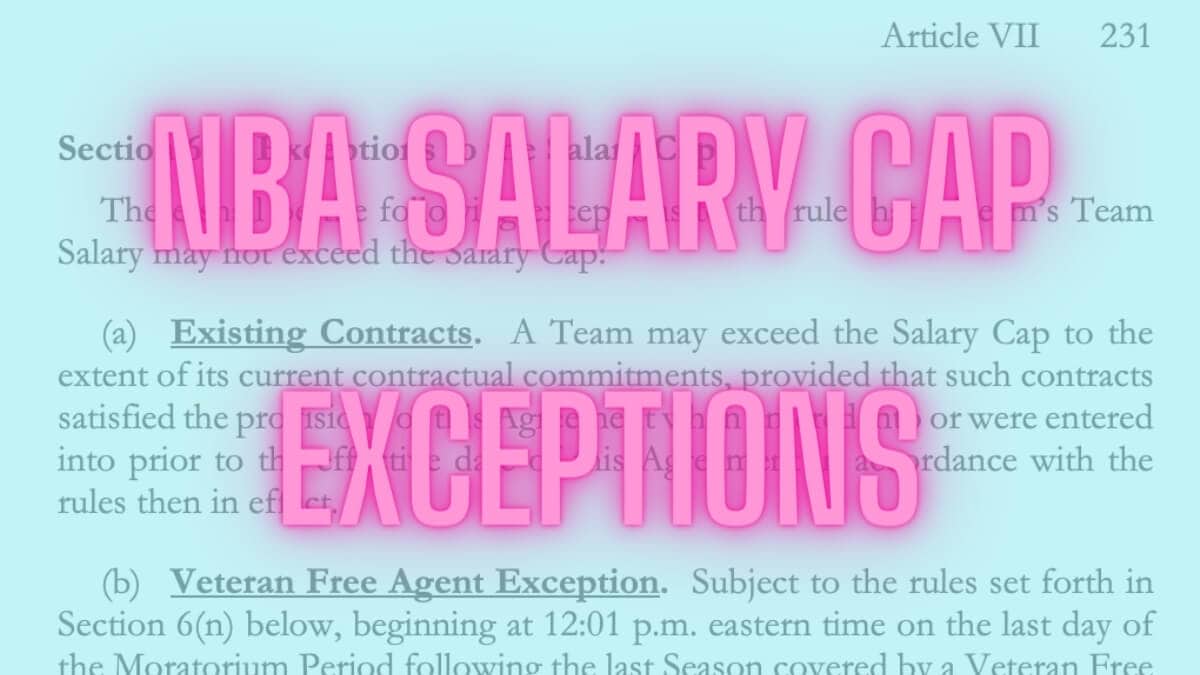The NBA salary cap exceptions are at the heart of understanding how the NBA salary cap functions. These little caveats can be combined to allow teams to circumvent the NBA salary cap and build out winning rosters.
For a lot of people, this stuff is the real game, navigating red tape to secure the perfect roster. See, the NBA uses a salary cap in an attempt to discourage teams with deeper pockets from spending themselves into a competitive advantage. But it’s a ‘soft’ salary cap. Meaning, teams are allowed to exceed the salary cap, so long as they follow certain rules.
So the NBA salary cap isn’t so much a hard wall as a
Collectively, these rules are known as the NBA’s salary cap exceptions. Most of the time you’ll just hear references to ‘cap exceptions’ or even just ‘exceptions’.
At a certain point, the rules are exhausted and teams start running into penalties and taxes. That’s outside of the scope of this article.
In the exact words of the CBA, these are the “exceptions to the rule that a Team’s Team Salary may not exceed the Salary Cap”.
There are a lot of them, which explains how we can have a salary cap at $136 Million while teams like the Clippers and the Warriors are still spending upwards of $200 Million on payroll.
Existing Contracts
This is magically simple, and yet complicated. If a previously negotiated contract floats your payroll over the cap, you don’t have to kick them off of your team.
Of course, there are a bunch of other rules which govern player contracts. And all of these contracts will have had to subscribe to those rules.
The Mid-Level Exceptions
Let’s start with the MLE’s. These are really the simplest exceptions. Basically, any player within the specified salary guidelines (that’s where the mid-level terminology comes in, these are for players making ‘mid-level’ salaries) can qualify for an MLE.
Mid-Level Salary Exception for Room Teams
For teams who have not yet hit the salary cap. Using this exception means that you cannot use the bi-annual exception or the other 2 Mid-Level Exceptions. This exception covers an amount equal to 5.678% of the Salary Cap for the given year. Limited to 3 seasons.
Non-Taxpayer Mid-Level Salary Exception
For teams who have crossed the salary cap, but still fall under the luxury tax. This exception covers an amount equal to 9.12% of the salary cap for the given year.
Contracts falling under this exception are limited to 4 seasons.
You can’t use the room exception and the non-taxpayer MLE in the same season.
Taxpayer Mid-Level Salary Exception
Can be used by teams above the luxury tax level. Limited to 2 seasons in length. This exception covers an amount equal to $5 Million * (current salary cap / 2023-24 salary cap). Can’t also use the room exception.
Traded Player Exceptions
These are the exceptions that govern trades. And this explains why trading can get so very complicated when teams exceed the salary cap.
Standard Traded Player Exception (STPE)
You can trade one player for one or more for players as long as the acquired players are making less than the salary of that one outgoing player, plus $250,000. You do have a year to find your replacement.
Aggregated Standard Traded Player Exception
You can replace multiple players with multiple players, making less than the salary of one outgoing player, plus $250,000. You have to find your replacement simultaneously.
For the 2023-24 season only, teams can simultaneously trade one or more players for one or more players who will have a post-trade salary of less than 110% plus $250,000 of the the pre-trade salaries of the players hey’ve sent away.
Expanded Traded Player Exception
Teams can trade players simultaneously if the acquired salaries are less than the greater of…
The lesser of… 200% of the outgoing trade plus $250,000 – or – 100% $7.5 Million * (current salary cap / 2023-24 salary cap)
– or –
125% of the outgoing trade plus $250,000
Room under the cap Exception
Trades for teams under the cap are allowed to float the cap by $250,000. this one is a little funny to me, because it’s necessary, but also why even have the cap?
Veteran Free Agent Exception
Disabled Player Exception
If a player gets hurt, you can get a replacement. That is, if through injury or illness, a member of your roster is unable to play, you can request a disabled player exception and sign a replacement. But you do have to get a doctor to attest that they won’t be able to play for the res of the season.
The replacement player should to be signed for at least 50% of the salary of the injured player for the current season. Or, if it’s less, the Non-Taxpayer Mid-Level Salary Exception. And the replacement player can be assigned for only one year, and must be in the final year of their contract.
Bi-Annual Exception
The bi-annual exception can only be used if it was not used during the previous season.
Rookie Scale Exception
Minimum Player Salary Exception
This exception lets you sign or acquire a player for two seasons, so long as their salary is the minimum amount allowed for that player.
Second Round Pick Exception
Reinstatement
Non-Aggregation
